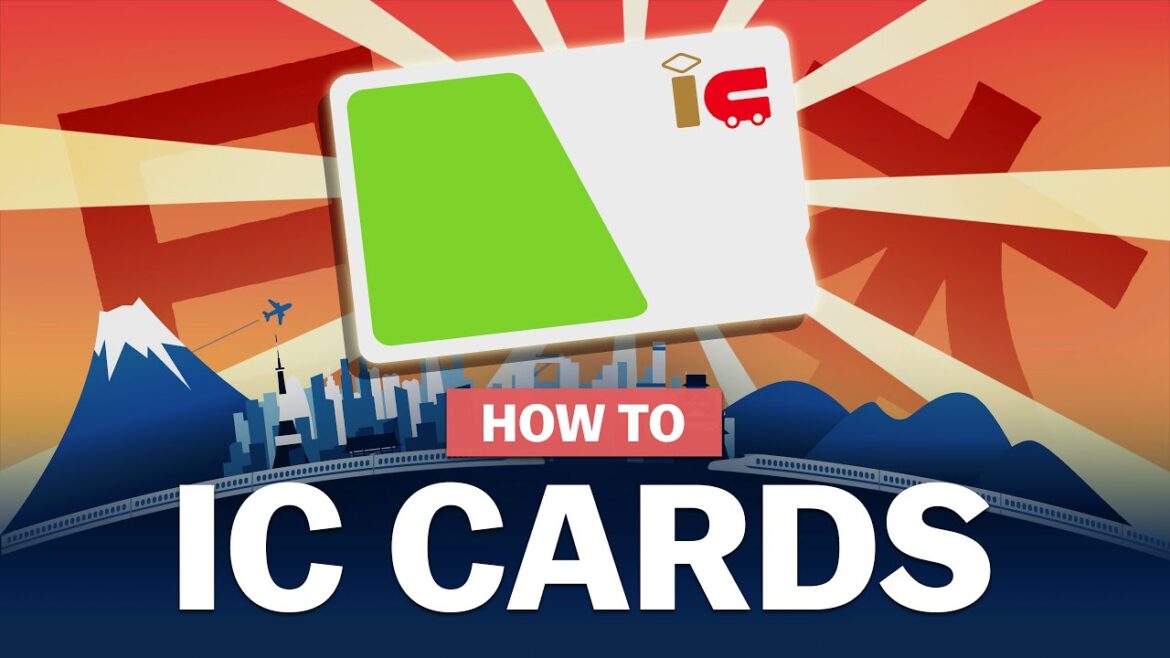Learn more about IC Cards: https://www.japan-guide.com/e/e2359_003.html
In this video, we will cover everything there is to know about IC Cards, what they are, how to use them and cover some of the issues you could encounter with them.
*IMPORTANT NOTICE:* Due to a shortage of IC chips, the sale of Suica and Pasmo cards is currently SUSPENDED until further notice. An exception is made at Narita Airport, Tokyo Station, Shinagawa Station, Shibuya Station, Shinjuku Station, Ikebukuro Station and Ueno Station, where Suica cards can be purchased at the “JR East Travel Service Centers”.
Furthermore, “Welcome Suica” cards can be purchased at Haneda Airport. Other IC cards, such as Icoca and Toica, are on sale as usual.
– Chapters –
00:00 Introduction
00:13 What are IC Cards?
00:58 Issues
01:40 How to use IC Cards
02:57 Mobile versions
03:15 Special IC Cards
04:06 IC Card on the shinkansen
05:00 Outro
– Video Credits –
Videographer: Charles Sabas
Produced by Stefan Schauwecker
For more information about Japan:
https://www.japan-guide.com/
Any questions regarding your future trip to Japan? Feel free to ask a question in our question forum:
https://www.japan-guide.com/forum/quedisplay.html
Convenient and easy to use, IC Cards can
be a great tool to help make your trip to
Japan an even smoother one. But what are IC
Cards? IC Cards (or Integrated Circuit Cards)
are rechargeable cards that can be used to
pay fares on public transportation as well
as make payments at shops, restaurants
and vending machines all over Japan.
There are dozens of local IC cards across
the country, and 10 of them can be used
interchangeably nationwide. Most relevant to
international tourists are Suica and Pasmo,
which can be purchased in the Tokyo area, and
Icoca, which is available around Osaka and Kyoto.
With one of these ten IC Cards, you
can ride on virtually all trains,
subways and buses in most of Japan’s
major cities, including Tokyo, Osaka,
Kyoto, Nagoya, Fukuoka and Sapporo. However
there are a few issues to keep in mind:
First of all, you cannot travel outside
IC card areas. Both your departure station
and the destination station need to be
located inside the IC card area. – You
cannot use an IC Card to travel between
most disjoint IC card areas. For example,
you cannot travel between Kanazawa and
Niigata or between Hiroshima and Fukuoka
You cannot use IC cards on shinkansen trains
unless you specially set up the card for it.
More about this later in the video.
Finally, when riding limited express
trains that require a supplement fee, you can
pay the base fare with the IC Card when passing
through the ticket gates, but the supplement
ticket needs to be purchased separately.
Now that we know a little bit more about what
an IC card is, let’s talk about how to use them:
IC Cards can be easily purchased at
ticket machines and ticket counters
of the issuing railway companies, for
example, Suica can be purchased at JR
stations in eastern Japan. The initial cost
consists of a 500 yen refundable deposit plus
an initial amount to be charged onto
the card, which is usually 1500 yen.
If you need to recharge your card, simply do
so at a ticket machine or a special re-charging
machine found in strategically meaningful
locations. Many convenience stores also
allow IC cards to be recharged at the cashier.
Note that any of the 10 nationwide IC cards can
be recharged anywhere in Japan, for example, it
is possible to recharge a Suica card in Osaka.
If you plan to return the card and
get your refundable deposit back,
simply do so by bringing it back to the
ticket counter of the issuing operator.
Unused credit can also be refunded minus
a handling fee. It is important to keep in
mind that the IC cards can be returned only
to the issuing company, so, for example,
Suica cards have to be returned at JR stations
in eastern Japan and cannot be returned in Osaka.
IC cards become invalid if they are
not used for 10 years. Therefore,
you can keep it in case you are
planning to come back to Japan.
Mobile versions of these cards
make them even more convenient:
If you have an Iphone 8 or a later model,
you can set it up to serve as Suica,
Pasmo and Icoca cards by adding the cards to
ApplePay. Most Android phones sold outside
of Japan, however, are currently not
set up to work as mobile IC cards.
Welcome Suica is a special version of Suica,
which is available only to international
tourists. It differs from the regular card in that
it requires no 500 yen deposit. On the other hand,
the card becomes invalid after 4 weeks and does
not allow for refunds of the remaining balance.
This removes the need for tourists to go through
the refund process at the end of their stay,
but attention needs to be paid to using
up the balance by the end of the trip.
Kansai One Pass is a special version of Icoca,
also available only to international tourists.
Unlike Welcome Suica, it behaves like a regular
IC card with a deposit fee and no 4-week expiry
period. The added benefit of the Kansai One Pass
are discounts offered to card holders at
selected tourist attractions and services.
These special IC cards are available at selected
stations frequented by international tourists.
As mentioned before, IC cards cannot be used on
shinkansen trains without some additional set
up. There are currently three systems that allow
you to use IC cards for riding the shinkansen:
The “Tokaido Sanyo Kyushu Shinkansen
Online Reservation” website allows
travelers to register their IC cards and
a credit card and buy tickets for rides
on shinkansen trains between Tokyo, Osaka
and Kyushu. Registered IC cards can then
be used to pass through the ticket gates,
but note that the fare is subtracted from
the registered credit card rather
than from the IC card’s balance.
A very similar system is offered in eastern Japan
through the JR East Online Reservation website,
which allows IC cards to be used in
combination with a registered credit
card on shinkansen trains from Tokyo to
Kanazawa, Niigata and northern Japan.
Alternatively, shinkansen trains in eastern
Japan can also be used on non-reserved seats
through the "Touch de Go" system, with the
fare being subtracted from the card’s balance.
So there you have it, all the basic
things to know about IC cards. Check
out the link in the description
of this video for more details
on the subject. We hope this video helped
make your future trip an even easier one.
For more information or to watch another
video, click the links on the screen now,
or head over to japan-guide.com, your
comprehensive up to date travel guide
first hand from Japan. Thanks for
watching! Be sure to subscribe and
click the notification bell for more
videos about Japan. Happy travels!


9 Comments
IMPORTANT NOTICE: Due to a shortage of IC chips, the sale of Suica and Pasmo cards is currently SUSPENDED until further notice. An exception is made at Narita Airport, Tokyo Station, Shinagawa Station, Shibuya Station, Shinjuku Station, Ikebukuro Station and Ueno Station, where Suica cards can be purchased at the "JR East Travel Service Centers".
Furthermore, "Welcome Suica" cards can be purchased at Haneda Airport. Other IC cards, such as Icoca and Toica, are on sale as usual.
useful, thank you!
Ic card should be working countrywide 🤦♂️
The tourist Pasmo or Suica cards costs 1500 yen and nonrefundable. This video omitted that for some reason. Also omitted was the fact that you must show your passport at the time of purchasing a tourist Pasmo or Suica card. Without your passport, they cannot or will not sell you one. Because of this, I strongly recommend buying the card at the airport when you arrive instead of trying to locate a station that sells the IC cards.
Weird that the video doesn't mention even just once that IC cards can only be recharged with cash, that's kinda crucial. And not mentioning Passmo Passport alongside Welcome Suica feels like another oversight.
FYI: mobile IC cards (iPhones) can also be recharged with cash at a station that has recharge machines. But easiest is through Apple pay if you have it set up.
obsolute tech
This is one of those things in Japan that makes me crazy and scream why japan why. For every high tech thing japan does there is one of these that pushes them backwards. Just use credit cards like every other developed nation. Instead they created this system that is archaic and full of silly rules for use in one region but not another and only in cash in a rapidly cashless society. If japan is concern about credit card fees for merchants the merchant can just pass that to consumers like everybody else. I much rather pay higher prices than spend time with this essentially debit card but 10x worse.
Yay merci Charly